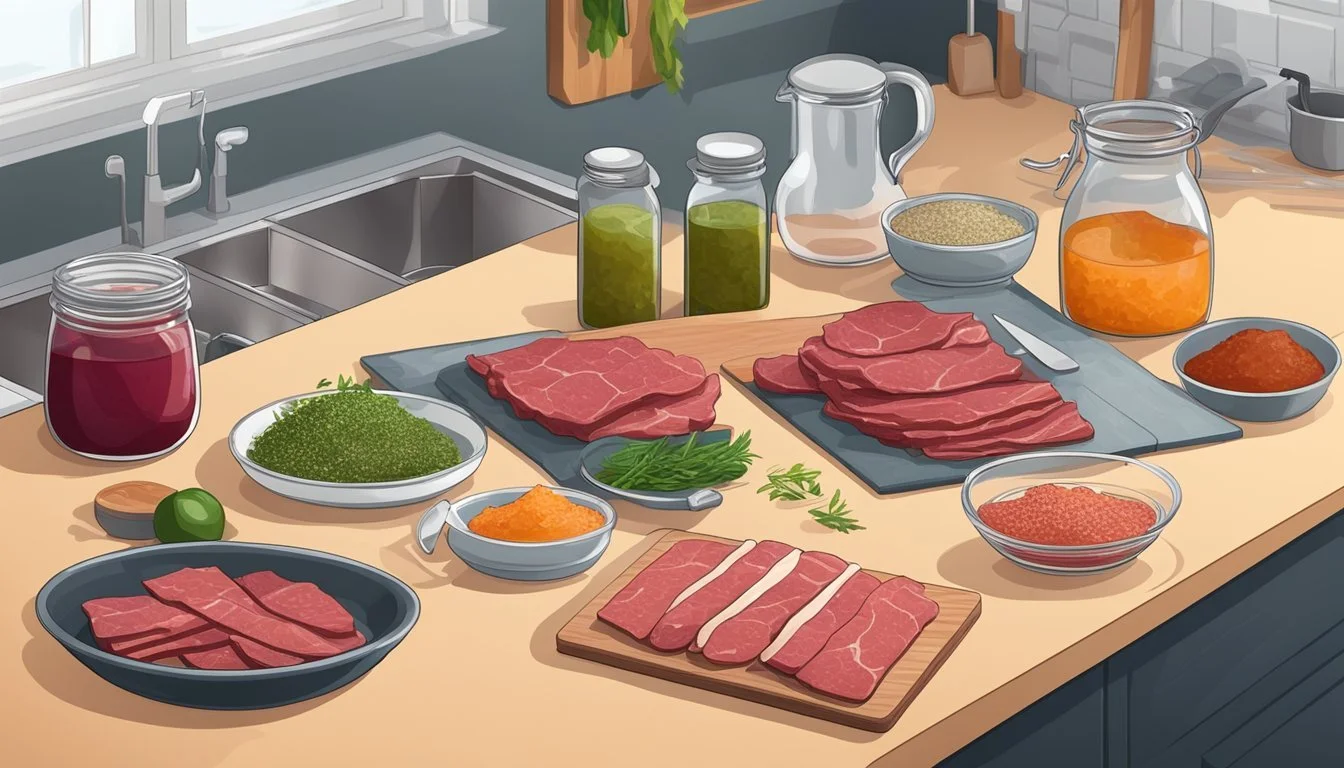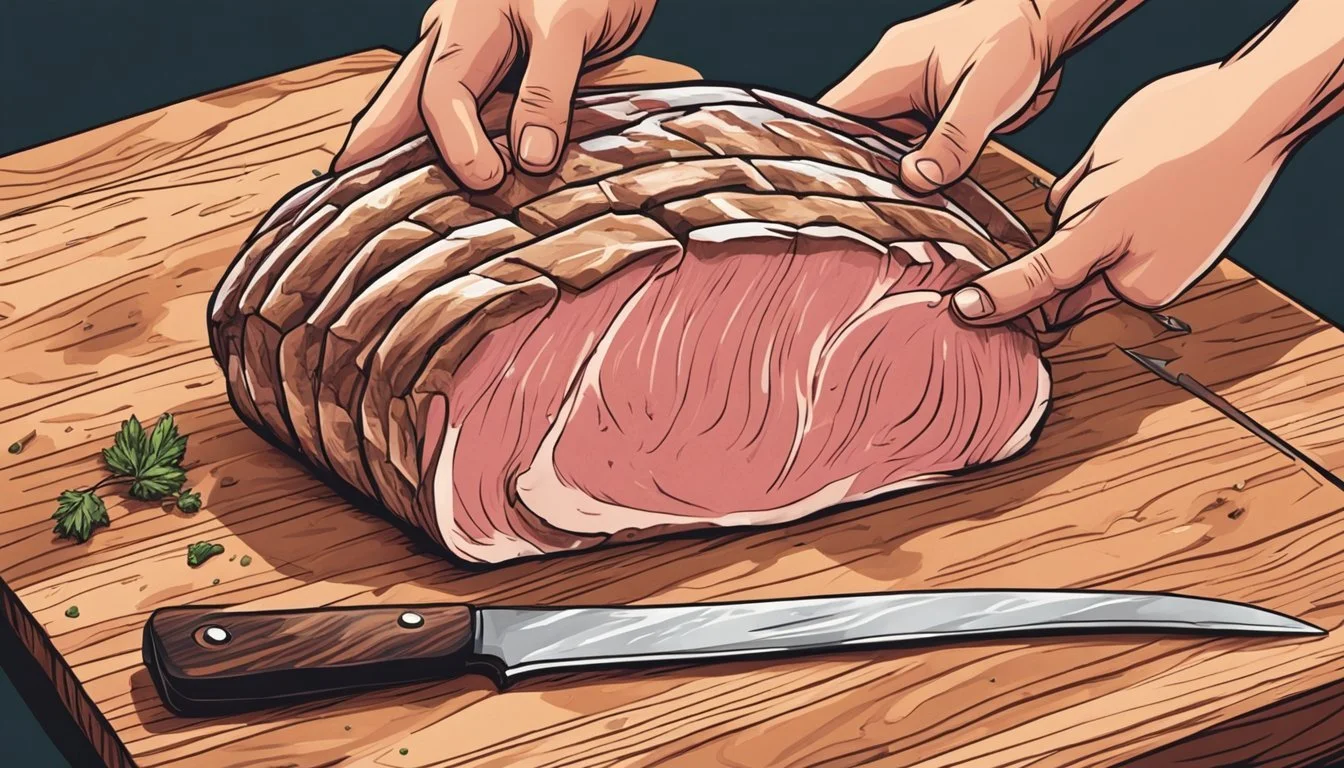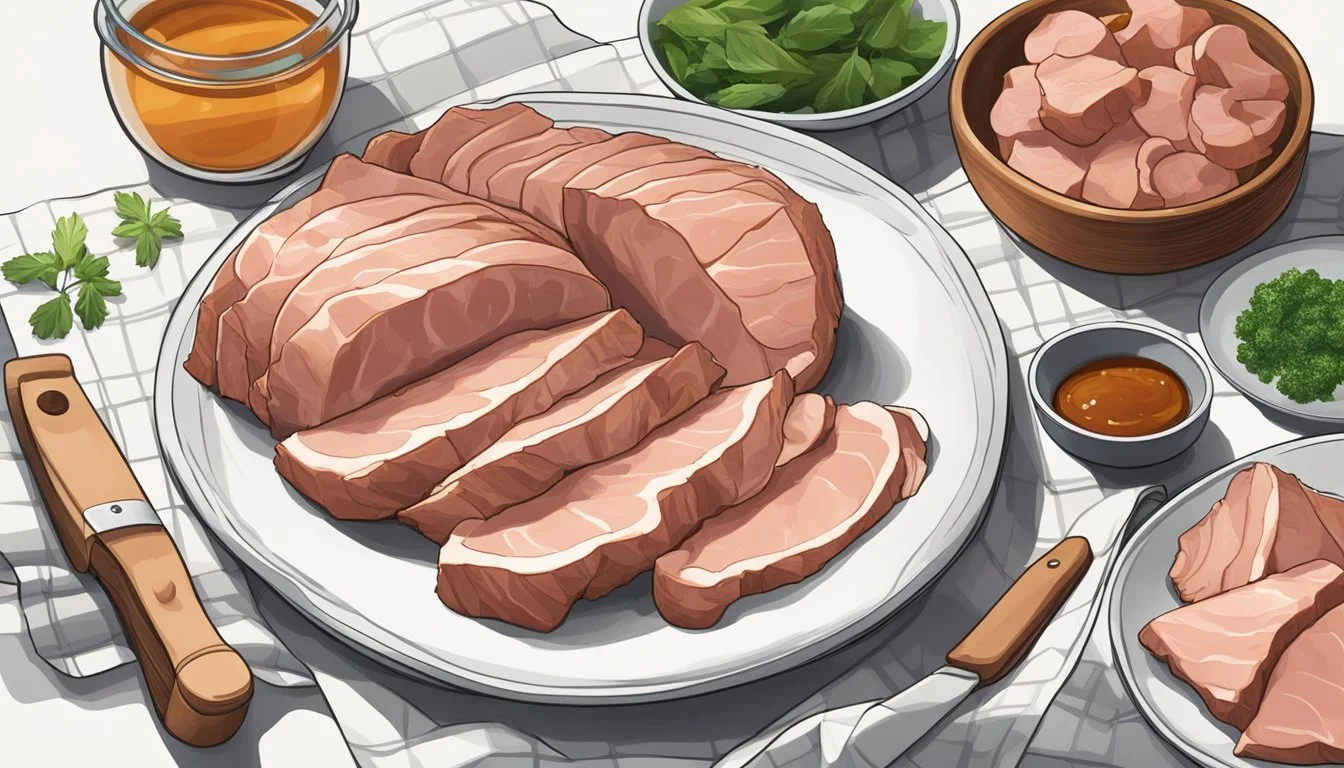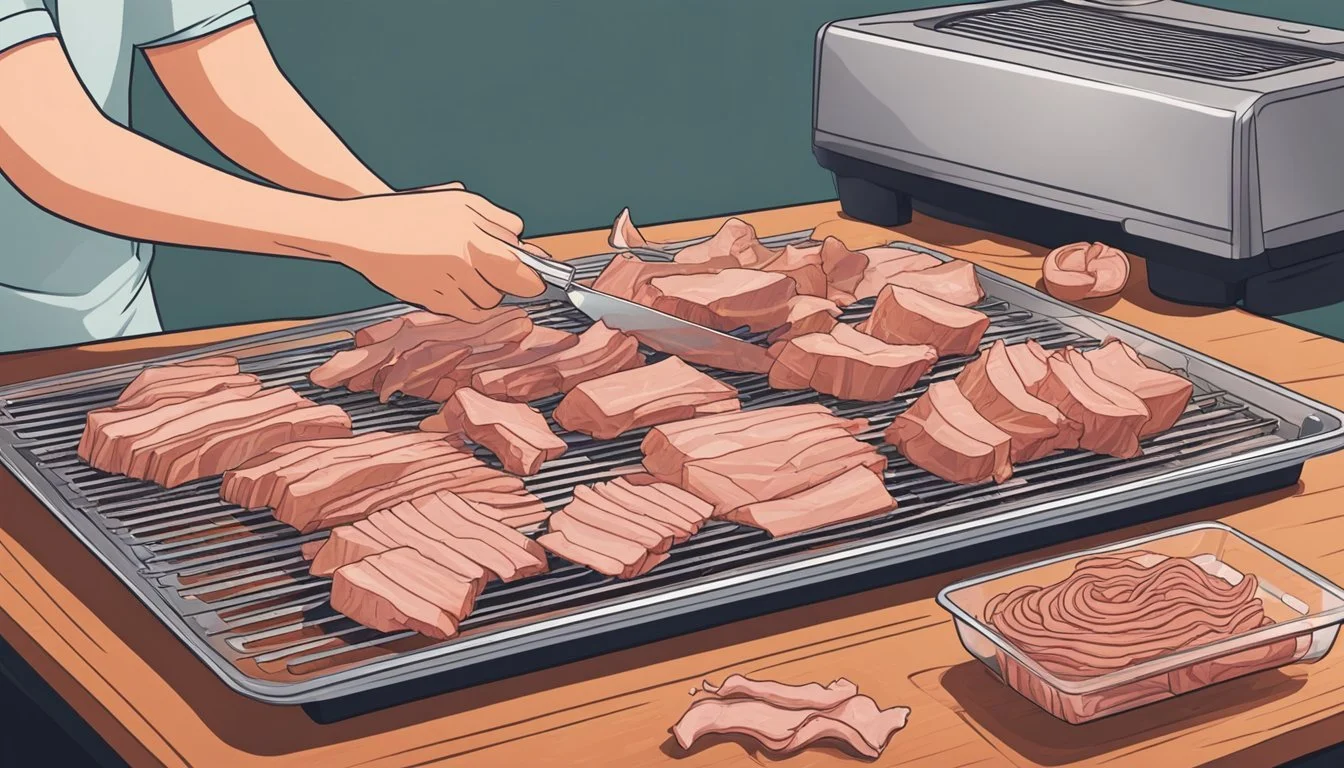How to Make Your Own Pork Jerky
A Beginner's Guide to Crafting Homemade Snacks
Making your own pork jerky can be a satisfying project for those who enjoy crafting homemade snacks with rich flavor profiles. Unlike other jerky that typically uses beef, pork jerky brings a distinct taste and texture that may just become a favorite for home chefs and snack enthusiasts alike. It involves slicing pork into thin strips, marinating them with a blend of savory spices, and drying them out until they achieve that characteristic jerky chew.
The process of making pork jerky requires careful attention to detail, especially when it comes to the preparation of the meat. For a successful batch, it's crucial to trim away excess fat, as it can cause the jerky to spoil faster. Selecting the right cut is equally important, with leaner cuts like pork loin being ideal choices to ensure a tender yet firm texture in the final product.
When it comes to drying, there are several methods available, including using an oven, smoker, or dehydrator. Each technique has its own set of guidelines to ensure the meat dries evenly and develops the desired dry but pliable consistency. Proper drying not only preserves the meat but also concentrates its flavors, resulting in a delicious, protein-packed snack that can be enjoyed on the go or as an addition to various meals.
Understanding Jerky and Its Varieties
Jerky is a versatile snack that comes in various flavors and textures. It's made through a process of dehydration which concentrates the meat's flavor and extends its shelf life.
The Basics of Jerky
Jerky is traditionally made by drying lean meat to prevent spoilage. The moisture content is reduced significantly, typically through air drying, smoking, or using a dehydrator at low temperatures. This process not only preserves the meat but also imparts an intensive flavor and chewy texture. Any meat can be transformed into jerky, from beef to pork, and even turkey, chicken, fish, and various types of game.
Method: Dehydration (air drying, smoking, dehydrating)
Texture: Dry and chewy
Preservation: Reduction of moisture content
Different Types of Jerky
The most common type of jerky is beef jerky, often favored for its rich flavor and wide availability. However, pork jerky is gaining popularity due to its inherent sweetness and tender texture. Turkey and chicken jerky present leaner options with a subtler taste, while fish jerky, made from salmon or tuna, offers a distinct flavor profile with omega-3 benefits. Game jerky, including deer or bison, brings a wilder taste to the jerky spectrum that many appreciate.
Beef Jerky: Rich flavor, widely available
Pork Jerky: Sweet, tender
Turkey/Chicken Jerky: Leaner, subtle taste
Fish Jerky: Distinctive flavor, omega-3s
Game Jerky: Wild taste, less common
Each variety requires specific preparation techniques to optimize the flavor and texture, with recipes often tailored to the type of meat being used.
Selecting the Right Cut of Meat
Selecting the right cut of meat is essential for making quality pork jerky. It ensures proper drying and provides the ideal texture for the finished product.
Choosing Your Meat
When embarking on the pork jerky-making journey, one should start with a cut that is inherently lean. The presence of fat in meat causes difficulty in preservation and may lead to the jerky becoming rancid. Therefore, identifying a lean pork cut is fundamental.
Eye of Round: Regarded as one of the best cuts for jerky, its leanness is suited for drying without becoming tough.
Sirloin: A relatively lean cut that balances flavor and a moderate amount of fat, making it suitable after trimming.
Lean Meat Selection
Pork jerky thrives on low-fat content. Lean meat not only dries more efficiently but also has a longer shelf life as less fat translates to less risk of spoilage. Here's what to look for:
Fat Content: Opt for cuts with minimal visible fat. If fat is present, trim it off meticulously.
Texture: Seek cuts that are firm. This quality indicates lower fat levels and will produce better jerky after dehydration.
By adhering to these guidelines, one ensures their pork jerky is both delicious and preserved well.
Preparation Before Drying
The path to delicious homemade pork jerky begins with meticulous preparation. Ensuring that the pork is properly trimmed and sliced, and that the marinade is well-crafted, sets the foundation for a flavorful and successful jerky.
Trimming Fat and Slicing the Meat
One must trim the excess fat from the pork to prevent spoilage during storage, as fat does not dehydrate well. Fat can make the jerky rancid over time. It's advisable to select lean cuts such as pork loin or tenderloin. Using a sharp knife, the meat should be sliced against the grain. Slicing against the grain ensures that the jerky is tender and easier to chew. Strips should be uniform in thickness, which can be achieved by gently flattening the slices with a rolling pin. Thickness should be consistent, about 1/4 inch thick, to ensure even drying.
Marinating Basics
Marinating the meat is essential for both the safety and flavor profile of the jerky. A marinade commonly includes acidic components, salt, and a blend of spices and seasonings that impart the desired flavor to the pork. The pork slices should be immersed in the marinade and stored in the refrigerator. For full flavor absorption, marinating for a period between 12 to 24 hours is recommended. After marinating, one should pat the pork dry with paper towels to remove excess moisture. This step is crucial for achieving the optimal drying process.
Creating Your Jerky Marinade
Creating the ideal marinade is essential for flavorful pork jerky. A marinade not only imparts taste but also tenderizes the meat. The balance of flavors and selection of spices are pivotal in defining the character of your homemade jerky.
Choosing Your Flavor Profile
The flavor profile of pork jerky can range from sweet and spicy to savory. One must select ingredients that harmonize well with pork’s natural flavors. Common components of a marinade include soy sauce, for its umami properties, and Worcestershire sauce, which adds complexity. For heat, one might opt for black or chili pepper, while sweetness can come from brown sugar or honey. To infuse the meat with aromatic flavors, garlic or garlic powder, as well as onion powder, are popular choices.
When crafting your marinade, consider how these elements will blend:
Soy Sauce: Adds saltiness and depth.
Garlic/Garlic Powder: Offers a pungent and earthy flavor.
Onion Powder: Gives a subtle sharpness and sweetness.
Black Pepper: Provides a spicy kick.
Sweet Elements: Balance and counteract the heat.
Worcestershire Sauce: Introduces a slight tanginess and additional complexity.
Marinade Recipes
When developing recipes, it's crucial to strike a balance where no single flavor overpowers the others. Here are suggested ratios for two distinct marinades:
Sweet and Spicy Marinade:
1/2 cup soy sauce
1 tablespoon Worcestershire sauce
2 tablespoons honey or brown sugar
1 tablespoon garlic powder
1 tablespoon onion powder
1 teaspoon ground black pepper
1/2 teaspoon chili flakes (optional for extra heat)
Savory Herb Marinade:
1/2 cup soy sauce
1/4 cup Worcestershire sauce
1 tablespoon garlic powder
2 teaspoons onion powder
2 teaspoons ground black pepper
1/4 cup mixed dried herbs (such as thyme, rosemary, and parsley)
These are merely starting points. Individuals are encouraged to experiment with quantities and additional spices to discover the flavor profile that suits their taste. After choosing a recipe, combine all ingredients in a large bowl and add the pork slices, ensuring they are fully submerged. For optimal infusion, marinating should be done for at least four hours or, ideally, overnight.
Drying the Meat
Properly drying the meat is essential to creating flavorful and safe-to-eat pork jerky. This stage impacts texture and shelf life and requires attention to time, temperature, and method.
Methods of Drying Meat
There are several effective approaches one can use to dry pork for jerky:
Oven Drying: Set the oven to the lowest temperature, typically between 160°F and 180°F. Arrange marinated pork slices on cooling racks over baking sheets to enable airflow, ensuring an even dehydration process.
Dehydrator Machine: Preheat the dehydrator to 155-165 degrees F. Place pork slices on mesh trays, spaced out to allow for circulation.
Sun-Drying: Although not commonly used for making pork jerky due to safety concerns and environmental variables, sun-drying involves exposing the meat directly to sunlight. It is crucial to maintain sanitary conditions and consistent airflow.
For all methods, ensure the meat is in a single layer and that pieces do not overlap to guarantee uniform drying.
Understanding Dehydration Process
Dehydrating pork involves removing moisture to a point where bacteria cannot thrive. Here’s what one needs to consider:
Drying Time: Varies depending on slice thickness and method. For thin slices (1/8 inch), expect 4-6 hours. Medium slices (1/4 inch) may take 6-8 hours, while thick slices (1/2 inch or more) can require 8-10 hours.
Temperature: A range of 155-165 degrees F is recommended to effectively dry the meat while minimizing the risk of bacterial growth.
End Result: The meat should feel dry to the touch and be flexible yet not brittle.
Upon completion, store the pork jerky in an airtight container to preserve freshness and extend shelf life. It's essential to let the jerky cool before storage to prevent condensation.
Safe Jerky Making Practices
When making pork jerky, it's crucial to adopt safe practices to prevent bacterial contamination and ensure that the jerky is stored properly to maintain its freshness and safety for consumption.
Preventing Bacterial Contamination
To prevent bacterial contamination, one must strictly adhere to clean preparation areas and thorough cooking processes. Surfaces and utensils should be sanitized with a solution of water and bleach.
Choose Lean Meat: Bacteria thrive in fatty areas, so starting with lean cuts of meat is essential.
Marination: Always marinate meat in the refrigerator to keep bacteria at bay.
Cooking Temperature: Dry pork jerky in a dehydrator or oven at a minimum temperature of 145°F to 155°F for at least 6 hours.
Post-Drying Heating: After drying, heat the jerky in a preheated oven at 275°F for 10 minutes to kill any remaining pathogens.
Proper Storage Methods
After drying and heating, the jerky must be stored properly to avoid spoilage and bacterial growth.
Short-Term Storage:
Cool the jerky completely before packaging.
Store in airtight containers.
Keep the containers in a cool, dry place away from direct sunlight.
Long-Term Storage:
For prolonged storage, vacuum seal the jerky to remove air and moisture.
Place the sealed jerky in the refrigerator or freezer.
When stored in the freezer, jerky can last for several months, providing safety against bacteria and spoilage.
Additional Tips and Tricks
When making homemade pork jerky, one has several advantages and essential tools at their disposal. These can significantly enhance the quality and flavor of the jerky. Below are detailed insights into both.
Homemade Jerky Advantages
Healthier Options: Homemade jerky allows for complete control over ingredients, avoiding preservatives found in commercial products. Customization: One can tailor recipes to personal taste preferences, experimenting with different flavors and marinades.
Jerky Preparation Tools
Meat Grinder: A meat grinder ensures even texture and thickness, crucial for uniform drying of the jerky.
Tool Purpose Cooking Spray To lightly coat dehydrator trays, preventing sticking Dehydrator Trays Arranging the meat for effective drying Sharp Knife For cutting consistent, thin slices of meat
Careful use of these tools facilitates the crafting of high-quality, flavor-rich jerky.
Serving and Using Your Homemade Jerky
Once your homemade jerky is prepared and has undergone the drying process, it becomes a versatile ingredient known for its rich flavor and preserving qualities. This dried meat can be enjoyed in a variety of ways, from a simple snack to a flavorful addition to meals.
Savouring Your Jerky
Jerky is prized for its convenience and rich flavor, making it a perfect on-the-go snack. It’s best enjoyed at room temperature, which allows its nuanced flavors to shine. The jerky should be chewy with a firm texture, yet pliable enough not to be brittle. Upon finishing the drying process, let the jerky rest so the flavors can settle and intensify. Serve it as:
A standalone snack: Enjoy slices throughout the day for a protein boost.
A tasting platter: Pair with cheeses, fruit, and nuts for a savory appetizer.
To maintain its quality, store jerky in airtight containers to prevent moisture absorption and to preserve its flavor and texture.
Jerky in Recipes and Meals
Jerky isn’t only a snack; it can be a flavorful component in various recipes. Its concentrated taste and preserved state make it ideal for cooking, where it adds a burst of savory seasoning. Here are a couple of ways to incorporate jerky into meals:
Dice into bits: Add to omelettes or scrambled eggs for a breakfast twist.
Incorporate into soups: Rehydrate strips in broths to infuse soups and stews with deeper flavor profiles.
By using jerky in recipes, one can maximize its utility, extending its use beyond simple snacking to enrich the flavor profiles of home-cooked meals.
Advanced Jerky Making Techniques
For the seasoned jerky maker, mastering advanced techniques can elevate your homemade pork jerky from good to gourmet. These methods involve tweaking recipes, leveraging specialized equipment, and playing with a variety of flavors and textures to create unique, high-quality treats.
Experimenting with Flavors and Textures
To enhance flavors and textures, a chef might experiment with different marinades that combine an array of spices, herbs, and sauces. Key ingredients could include soy sauce for umami, honey or brown sugar for sweetness, and chili flakes or cayenne for a spicy kick.
Marinade Recipes: Craft unique marinades based on classic profiles – smoky, sweet, tangy, or spicy.
Texture: Adjust slicing techniques to affect chewiness; against the grain for a tender bite, with the grain for a more robust chew.
Using Smokers and Dehydrators
For those who seek to intensify the distinct smoked taste in their jerky, a smoker presents an invaluable tool. By using various types of wood chips, such as hickory or maple, they can infuse the pork with complex smoky flavors not achievable in ovens.
Smokers: It is recommended to maintain a steady temperature of 160°F to 180°F, slowly cooking the jerky to imbue it with rich, smoky notes.
When dehydrators are used, the chef ensures a consistent drying temperature, which is critical for creating evenly dehydrated jerky without cooking the meat.
Dehydrators: Set the appliance to 160°F, space marinated pork slices on trays without overlap, and typically dehydrate for four to eight hours until the desired dryness is reached.
Economical Aspects of DIY Jerky
Creating pork jerky at home can be a cost-effective alternative to purchasing from a store, offering not only potential savings but also the convenience of readily available snacks.
Cost-Effectiveness of Homemade Jerky
Homemade jerky allows individuals to save money by controlling portions and selecting ingredients themselves. The cost per ounce for DIY pork jerky is significantly lower when compared to the premium prices of pre-packaged jerky. For example, purchasing pork in bulk and utilizing home spices and marinades reduces the price per batch. Here's a simple cost breakdown:
Bulk Pork Purchase:
Cost: $4.00 per pound
Yield: Approximately 8 ounces of jerky
Marinade Ingredients:
Cost: $2.00 (for homemade marinade using pantry items)
Total Cost for Homemade Jerky:
Approximately $6.00 for 8 ounces
Comparable Store-bought Jerky:
Cost: $12.00 for 8 ounces
By avoiding store premiums, one can almost halve the cost of their jerky consumption, which translates to significant savings over time.
DIY Versus Store-Bought
The convenience factor of making jerky at home is an intangible benefit that reflects economically. A person doesn't need to travel to a store as frequently if they produce their own supply of jerky. This reduces travel expenses and time spent shopping, contributing to overall savings. Moreover, home preparation eliminates the need for the costly packaging and marketing factored into store-bought jerky prices.
In contrast, store-bought jerky offers immediacy and variety but at a marked-up price to cover the expenses of commercial preparation, packaging, and distribution. While store-bought may be convenient for a quick purchase, it lacks the cost-saving aspect of the do-it-yourself method.
Jerky for Outdoor Activities
Pork jerky is an excellent source of protein for outdoor enthusiasts, providing a lightweight, convenient, and nourishing snack. It holds up well in various climates and doesn't require refrigeration, making it ideal for extended trips away from modern conveniences.
Jerky as a Travel Snack
For those who are constantly on the move, pork jerky stands out as an exceedingly practical option. It's non-perishable and withstands temperature fluctuations, which is valuable when access to cool storage is unpredictable. A few key characteristics make it particularly suitable for travel:
High-Protein Content: Jerky is densely packed with protein, crucial for maintaining energy levels when engaging in strenuous activities.
Portability: Lightweight and compact, jerky can be easily stowed in a backpack or pocket.
When preparing jerky for travel, individuals should ensure it is dry enough to prevent spoilage but still pliable to avoid toughness.
Preserving Meat for Camping and Backpacking
Campers and backpackers often seek food options that are not only convenient but also safe and long-lasting. Pork jerky fits this niche effectively:
Long Shelf Life: Properly dried jerky can be stored for weeks, making it a reliable protein source for extended outdoor adventures.
Easy Storage: With no need for refrigeration, jerky is an effortless addition to any camper's food supply.
To preserve jerky for camping or backpacking, it's crucial to start with lean cuts of pork and to remove as much fat as possible, as fat can cause the jerky to spoil faster. By using a dehydrator or oven to slowly remove moisture, individuals can create jerky that is dry, durable, and less susceptible to mold or bacteria.
Health Considerations of Jerky
Making pork jerky can be a healthy snacking option, provided that one pays attention to the nutritional content and seasoning choices. This section explores these critical aspects in detail.
Nutritional Information
Pork jerky is a high-protein snack with minimal carbohydrates, making it suitable for those following low-carb diets. The drying process concentrates the protein content while greatly reducing the water weight. However, one should note that jerky can also be high in sodium and, depending on the preparation, potentially significant in fats.
Nutritional highlights (per 1 oz serving):
Protein: Approximately 9-15 grams
Carbohydrates: 1-3 grams
Fats: 1-5 grams (varies based on cuts of pork and preparation)
Sodium: Can vary widely depending on seasoning (often above 500 mg)
Mindful Seasoning Choices
Seasoning choices can significantly impact both the flavor profile and the healthiness of pork jerky. When choosing seasonings, one must be cognizant of sodium and sugar content, which can add up quickly, especially in premade mixes. Natural seasonings like herbs and spice blends without added salts or sugars are preferable for healthier jerky. Additionally, for those sensitive to certain ingredients, it is vital to consider potential allergens in seasonings.
Acids: Utilization of acids like vinegar or citrus can contribute to tenderizing the jerky without adding unnecessary sodium.
Sodium: Limit high-sodium ingredients like soy sauce and opt for low-sodium versions or alternatives like coconut aminos.
Sugar: Be cautious of the sugar content in marinades; use natural sweeteners or small amounts to control the intake of added sugars.












